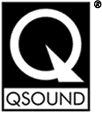Press Release
QSound Labs' microQ Selected as Audio Platform
by Wistron Corporation
Audiovox and AT&T Wireless currently shipping microQ™ enabled product - PPC4100 PDA Phone
CALGARY - July 28, 2004 - QSound Labs, Inc.
(NASDAQ: QSND), a leading developer of audio, and voice software
solutions, today announced a licensing agreement with Wistron Corporation,
formerly the design, manufacturing & services operations of Acer Inc., for
key microQ components, including the microQ Synthesizer, QXpander and
QSizzle/QRumble to improve high and low frequency audio components.
Wistron plans to integrate QSound’s microQ technology into a wide range of
mobile phones and PDAs - the first being AT&T Wireless’s newest PDA phone
the AudioVoxPPC4100, which is currently available in the United States.
“QSound’s microQ technology offers a superior audio solution that is
ideally suited to meet the needs of our product designs,” stated Honda
Hwang, Chief Handheld and Mobile Communication head of Wistron
Corporation. “Its cutting-edge capabilities and cost savings greatly
increase our ability to fulfill demanding design and manufacturing
requirements for next generation mobile devices."
"We are pleased to add Wistron to the growing list of partners who
have chosen the microQ audio engine for their mobile products,” stated
David Gallagher, president and CEO of QSound Labs. “The PDA phone market
is at an early stage so, in the short term, the revenue potential for this
segment is minimal but the continuing adoption of the microQ platform
throughout the mobile marketplace bodes well for the future."
About microQ:
microQ is a compact, hardware-independent and highly efficient software
audio engine providing functions such as polyphonic ringtones, video game
sounds, music playback, digital effects and recording for portable
applications, including Internet appliances, hand-held and mobile devices.
A low-cost and flexible option for consumer electronics and mobile device
manufacturers, microQ is inherently modular, scalable and portable. Its
core components include a digital audio playback engine, a wavetable
synthesis engine with a scalable sample set, and a multi-channel stereo
mixer. Additionally, microQ offers a wide range of processes to control
frequency response, dynamics and spatial enhancements, as well as full 3D
positional audio.
About Wistron Corporation:
With over twenty years experience and a strong engineering base in
product development, Wistron is a leader in the delivery of innovative
electronics manufacturing services. A focus on ICT (information,
communication and technology) products and partnerships with leading IT
technology companies means Wistron can incorporate the latest technology
platforms into product offerings to OEM customers. Customers quickly move
ahead with their market product introduction plans by relying on Wistron
to manage part or all of their product development plans. For more
information visit www.wistron.com.
About QSound Labs, Inc.:
Since its inception in 1988, QSound Labs, Inc. has established itself as
one of the world's leading audio technology companies. The company has
developed proprietary audio solutions that include virtual surround sound,
positional audio and stereo enhancement for the consumer electronics,
PC/multimedia, Internet and healthcare markets. QSound Labs’ cutting-edge
audio technologies create rich 3D audio environments allowing consumers to
enjoy stereo surround sound from two, four or 5.1 speaker systems. The
company’s customer and partner roster includes Toshiba, Philips,
Panasonic, Sharp, Aiwa, and Electronic Arts, among others. To hear 3D
audio demos and learn more about QSound, visit our web site at http://www.qsound.com.
This release contains
forward-looking statements within the meaning of the Private Securities
Litigation Act of 1995 concerning, among other things, Wistron’s plans to
use microQ in its products, distribution of microQ-enabled PDA phones, and
anticipation of continuing adoption of microQ in the mobile marketplace.
Investors are cautioned that such forward-looking statements involve risk
and uncertainties, which could cause actual results, performance or
achievements of QSound, or industry results to differ materially from
those reflected in the forward-looking statements. Such risks and
uncertainties include, but are not limited to, risks associated with
continued licensing and use of microQ, acceptance of microQ by OEM, ODM’s
and consumers, continued growth of the wireless devices market, dependence
on intellectual property, rapid technological change, competition, general
economic and business conditions, and other risks detailed from time to
time in QSound's periodic reports filed with the SEC. Forward-looking
statements are based on the current expectations, projections and opinions
of QSound's management, and QSound undertakes no obligation to publicly
release the results of any revisions to such forward-looking statements
which may be made, for example to reflect events or circumstances after
the date hereof or to reflect the occurrence of unanticipated events.

